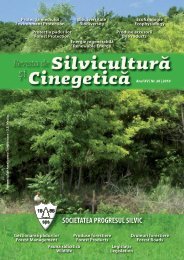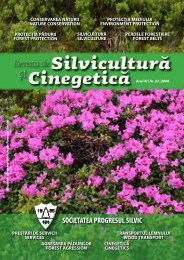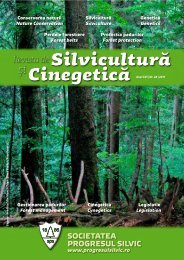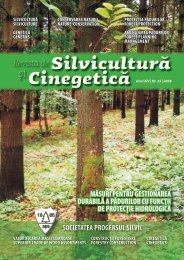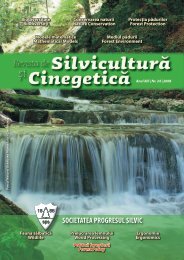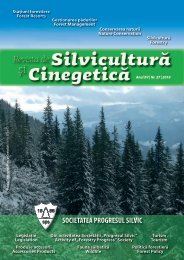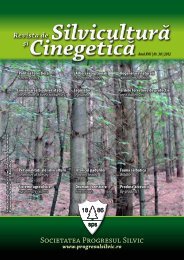Silviculture and Cinegetics Review - Societatea Progresul Silvic
Silviculture and Cinegetics Review - Societatea Progresul Silvic
Silviculture and Cinegetics Review - Societatea Progresul Silvic
Create successful ePaper yourself
Turn your PDF publications into a flip-book with our unique Google optimized e-Paper software.
FORESTRY BELTS SILVICULTURE AND CINEGETICS REVIEW XVII/30/2012<br />
- Communication (road / railway) protection forest belts<br />
(Mărăşeşti-Putna Seacă - Vrancea, Balta Albă–Buzău,<br />
Lacu Sărat-Făurei-Brăila interval).<br />
For covering a large number of species in different site<br />
conditions (a total of 39 species of trees <strong>and</strong> shrubs), the<br />
itinerary research were extended to 30 more different<br />
forest belts (in Vrancea, Galaţi, Brăila, Vaslui, <strong>and</strong><br />
Buzău counties). Information on the behavior of the<br />
main forest species in different types <strong>and</strong> compositions<br />
of protective forest belts, installed in various site<br />
conditions, have been completed <strong>and</strong> compared,<br />
whenever necessary, with data from literature.<br />
3. Results<br />
The management on ecological basis of the protection<br />
forest belts should be based on good knowledge of the<br />
forest species <strong>and</strong> sites, knowledge <strong>and</strong> application of<br />
the laws governing the lives of these ecosystems, the<br />
multiple relationships between human communities <strong>and</strong><br />
their natural environment.<br />
The successful installation of the protection forest belts<br />
needs, on one h<strong>and</strong>, a careful choice of species of trees<br />
<strong>and</strong> shrubs <strong>and</strong> their judicious grouping in mixing<br />
formulas <strong>and</strong> schemes, <strong>and</strong> on the other h<strong>and</strong> – adopting<br />
of techniques appropriate to the local conditions.<br />
Action to install protection forest belts in the past had<br />
mostly the desired effect <strong>and</strong> a multitude of the species<br />
introduced at the time vegetate quite well compared to<br />
the conditions of vegetation (black locust, oleaster, wild<br />
cherry, dog rose, etc.). Research on behavior <strong>and</strong><br />
evolution of species have led to the conclusion that the<br />
installation of protection forest belts should impose the<br />
introduction of a diverse assortment of forest species,<br />
both trees <strong>and</strong> shrubs, with a high resistance to drought<br />
during summer, <strong>and</strong> that in the shortest time can reach<br />
dense st<strong>and</strong> closure.<br />
Photo 1. Soil protection forest belts, Perieni - Bârlad<br />
Photo 2. Field protection forest belts, Focşani<br />
Carrying out the protection function with maximum<br />
efficiency is conditioned by their composition, structure<br />
<strong>and</strong> placement on terrain <strong>and</strong> by the natural factors in<br />
the analyzed region (Photo 1, 2).<br />
The main results of research on the behavior of forest<br />
species used in the composition of the analyzed<br />
protection forest belts are presented below.<br />
Greyish oak (Quercus pedunculiflora) was used as<br />
main species in the field protection belts installed at<br />
Bărăganu Station (Călăraşi County), in the erosion<br />
protection forest belts at Perieni Research Station<br />
(Vaslui County) as well as in the railways protection<br />
forest belts (Balta Albă – Buzău County, Traian Sat –<br />
Brăila County), in their central corridor, in intimate<br />
mixture with field elm, Norway maple, ash, Tartarian<br />
maple, field maple <strong>and</strong> shrubs (Photo 3, 4). Considering<br />
the climatic conditions, it proves to be resistant to soil<br />
<strong>and</strong> atmosphere dryness, being adapted to the moderate<br />
dry climate of the forest steppe, but more dem<strong>and</strong>ing to<br />
the edaphic conditions, vegetating well especially on<br />
cambic <strong>and</strong> clay chernozems of the forest steppe.<br />
It shows slow growth in the first years after planting,<br />
which becomes more active after reaching dense state.<br />
(7-10 years). At Perieni, in the erosion protection forest<br />
36



